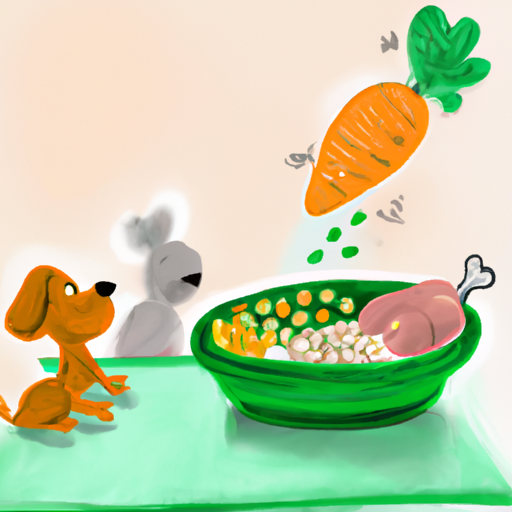As an informed and responsible dog owner, you’re probably familiar with the concept of kibble, the dry dog food that forms the basis of many dogs’ diets. Kibble provides a balanced diet for dogs of all ages, sizes, and breeds. However, did you ever wonder, “what can I add to my dog’s kibble” to make it even more nutritious and exciting? Well, you’re not alone. Many dog owners are seeking ways to enhance their pets’ meals, and we’re here to help you explore the variety of options available.
Table of Contents
- Understanding Kibble
- The Benefits of Adding to Your Dog’s Kibble
- Safe and Nutritious Additions to Kibble
- How to Add These Enhancements to Your Dog’s Meal
- Frequently Asked Questions
Key Takeaways
- Kibble, while balanced, can be made more exciting and nutritious with additions.
- Safe additions include cooked lean meats, vegetables, fruits, and supplements.
- Always introduce new food gradually to avoid digestive upset.
- Consult your vet before making significant changes to your pet’s diet.
Understanding Kibble
Kibble is a popular choice for pet owners due to its convenience, affordability, and balanced nutrition. It’s formulated to meet the dietary needs of dogs, providing essential proteins, fats, carbohydrates, vitamins, and minerals in every bite.
However, the world of kibble is not without its controversies. Concerns about fillers, preservatives, and the quality of ingredients have led many pet owners to seek ways to enhance their dog’s diet. Some are turning to raw or homemade diets, others to high-quality canned food, and others still are simply seeking ways to boost the nutritional value of the kibble they’re already feeding.
The Benefits of Adding to Your Dog’s Kibble
Adding to your dog’s kibble can have several benefits:
- Increased Nutritional Value: While kibble is designed to be a complete diet, it can lack in certain nutrients. Adding fresh, whole foods can provide these missing nutrients and contribute to your dog’s overall health.
- Enhanced Flavor: Let’s face it, eating the same thing every day can get boring. Adding different foods to your dog’s kibble can make mealtime more exciting.
- Improved Hydration: Many additions to kibble, such as bone broth or wet food, can increase your dog’s water intake, which is particularly beneficial for dogs that don’t drink enough water.
Safe and Nutritious Additions to Kibble
There are several foods you can safely add to your dog’s kibble to enhance its nutritional value and taste:
- Lean Meats: Cooked chicken, turkey, and fish are excellent sources of lean protein. Make sure they’re cooked thoroughly and avoid seasoning them, as some spices can be harmful to dogs.
- Vegetables: Carrots, green beans, and sweet potatoes are dog-friendly vegetables that can be cooked and mashed before adding to kibble.
- Fruits: Apples (without the core) and blueberries can be a healthy sweet treat to mix in.
- Supplements: Fish oil can be a great source of omega-3 fatty acids, and probiotics can help support your dog’s digestive health. Always consult with your vet before introducing supplements.
Remember, the additions should not make up more than 25% of your dog’s meal. The majority should still be kibble to ensure they’re getting a balanced diet.
How to Add These Enhancements to Your Dog’s Meal
Adding these enhancements to your dog’s meal is simple. Begin by introducing a small amount of the new food to your dog’s regular kibble. Gradually increase the amount over several days, monitoring your dog for any signs of digestive upset.
For example, if you’re adding cooked chicken to your dog’s diet, start by mixing a small amount into their kibble. Over the course of a week, slowly increase the amount of chicken while reducing the amount of kibble accordingly.
Remember, every dog is different, so what works for one might not work for another. Be patient and observant, and don’t be afraid to try different foods until you find what works best for your pet.
Frequently Asked Questions
1. Can adding to my dog’s kibble cause digestive upset?
Yes, introducing new foods too quickly can cause digestive upset. It’s best to introduce new foods gradually and watch for any changes in your dog’s behavior or stool.
2. Can I add human food to my dog’s kibble?
Yes, but it’s important to stick to foods that are safe for dogs. Avoid foods that are high in fat, salt, or sugar, and never feed your dog toxic foods like chocolate, grapes, or onions.
3. How often should I add to my dog’s kibble?
This can depend on the individual dog and what you’re adding. Some additions, like vegetables or lean meats, can be added daily, while others, like fruits or certain supplements, might be better suited to occasional use.
In conclusion, adding to your dog’s kibble can be a great way to provide them with additional nutrients and make mealtime more exciting. However, it’s important to do so safely and responsibly, always keeping your dog’s overall health and wellbeing in mind. If you’re considering a significant change to your dog’s diet, it’s best to consult with your vet first. They can provide guidance based on your dog’s individual needs and health status.
For more information on dog nutrition, you can refer to these articles on OneTopDog:
1. Understanding Dog Food Labels
2. The Benefits of Homemade Dog Food
3. The Debate About Raw Diets



